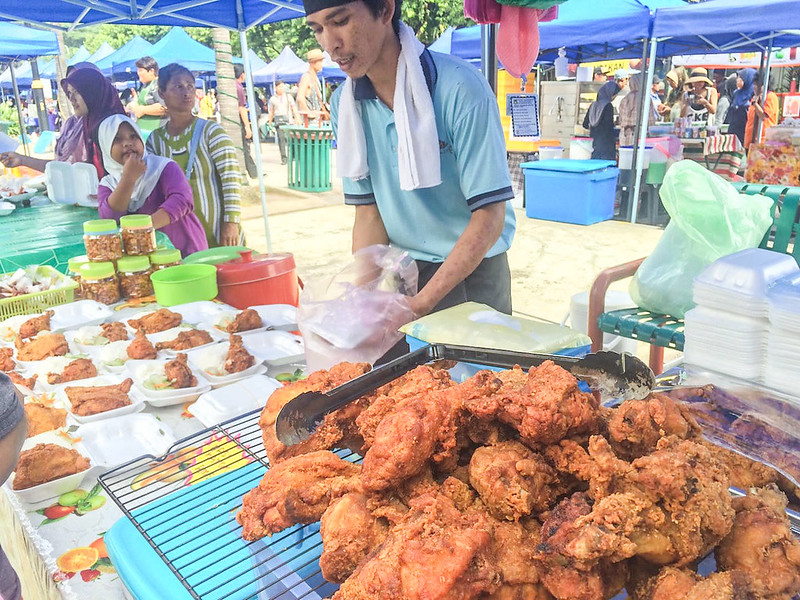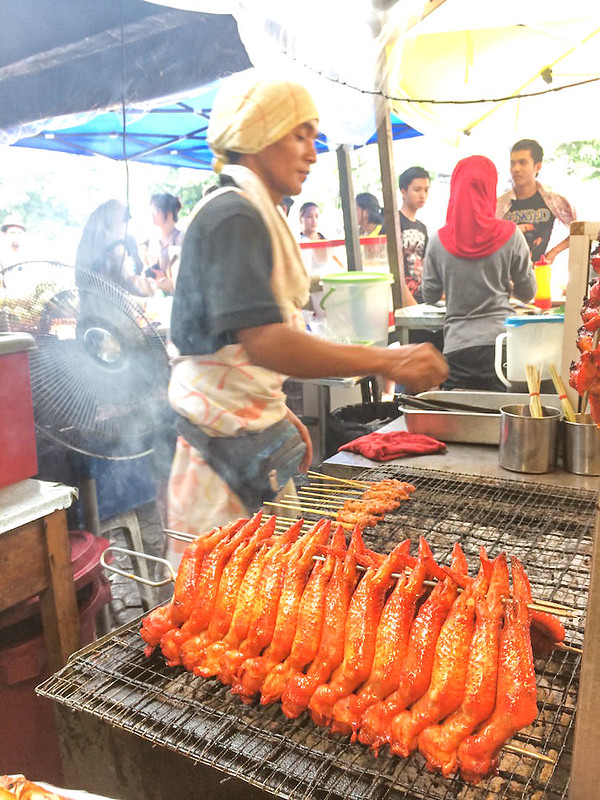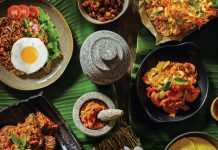By Justine Cheng
More than just nasi lemak, grilled fish, curry puffs, popiah and penjaram (a traditional Sabahan cake), the varieties of Ramadan street food serves not only to satisfy our palates but also gives us the feeling of eating at the home of our favourite aunt.
The food at the Ramadan markets is CAPTIVATING, scrumptious…an event that everyone with a penchant for food looks forward to each year. And year after year the markets get better and better with growing offerings. The markets are paradises abounding with comments such as, “there are so many things to eat in KK now!”, and, “Sabahans are setting up food stalls as if they have no other skill”.
Although the stalls are growing in number, each cook has proven themselves worthy through their skills. Selling at a Ramadan market is a testament in and of itself to a non-professional cook’s abilities. The cook’s food has clearly been proven delicious beforehand in order to garner a spot being sold at a popular place where young men and women converge to see and be seen.
Around 3 PM, confident prospective sellers set up their stalls with shades, some pulling out chairs and tables to easily entice us into their stalls.

When these charming specialty markets sprouted more than 20 years ago, only staples such as kuih muih, cakes, buns, banana or sweet potato fritters were offered. Occasionally, we would find fried tofu with cucumber slices which we poked into our mouths after dipping in one of the available sauces. At the time only authentic sauces made from fresh herbs were available. The familiar tomato and chilli sauces were nowhere to be seen.
Nowadays sauces can include sardine, squid, cockles, ikan bilis, sambal, etc. Needless to say, the various types of sambal also go with the ubiquitous rojak, satay and nasi lemak.

For special rojak to take away, it’s customary to use the tongs provided to fill plates with squid, fried taukua, fried prawn fritters, vegetables, and the like. The accompanying hot peanut sauce is packed in a separate container. It’s best to dip your food into the sauce instead of pouring the sauce onto your food.
Gravies can be concocted from coconut milk, fish and herbs. Because of the stiff competition, such gravies are eaten with noodles, accompanied by shredded duan selom, ulam raja and cabbage. And that’s not all… the whole combination is topped with small pieces of toasted belacan which resemble roast beef slices!
For those who don’t appreciate or understand belacan, they’ll surely enjoy it after this dish. One of the surprises in the markets is the coconut pancakes. These fluffy and savoury cakes are eaten with sardine sambal and a spicy egg and anchovy sambal.
For the grilled fish, mix cili padi, tamarind juice and belacan to give it some extra zing.Now, for the previously mentioned non-belacan eaters, there really won’t be any turning back after that combination.Getting to the markets early around 4 PM allows for a wide, fresh selection. It’s the best time to take home a meal of catfish, beef rending and vegetables, as well as seafood fried rice, topped with prawns and shellfish.
As cheap and cheerful as nasi campur is, the nasi kendar with ayam merah can also be addictive and is worth trying. Most masak merah dishes have the chicken soaking in hot gravy which is not the same as when it is deep fried. Crispy-skinned chicken is marinated in a spice mix so that the dish is well-infused with flavours when it’s cooked. A stand out dish that is always a winner is the petai or stink beans which is cooked with squid in a tangy and spicy sauce.
Of course, this list wouldn’t be complete without mentioning the popiah or spring rolls, something we eat every day. Especially exciting is that popiah mamak style can be found in these once-a-year markets. Filled with bean sprouts, yam bean, carrot, crushed prawn fritters, taukua and fried shallots, mamak-style popiah is eaten topped with home-made sweet sauce, crushed prawn fritters and fried shallots. Small unshelled prawns are bound together with flour and water and deep fried before being crushed into bits. The sweet sauce is made from a combination of peanuts, sugar, chilli, salt and water, while the addictive element comes from the fantastic sambal made from mint, coconut and chilli. It makes the curry-drenched rice even more appetising.
Some traders generously provide information on how to prepare their specialty sambal. But even with the recipe and ingredients, the end result can be a far cry from the original. A person may be enthusiastic about recreating the sambal but they still have a long way to go before they can achieve the same fantastic taste. Plus, the techniques and process leads to variances in the result of the sambal.
Popiah skin is made by rubbing a soft dough onto a heated griddle and lifting it up, 30 seconds later and voilah! Popiah perfection!
Another item too tempting to resist is the colourful and not-overly-sweet Nyonya kuih, the signature of Ramadan street food, alongside the satay, cendol and bur bur ca ca.
The refreshing concoction, cendol, is often soft and silky and the palm sugar-infused coconut milk is rich without being too creamy. The hint of saltiness in the drink can make it very pleasant. Options abound such as plain cendol and those with red beans and glutinous rice. The glutinous rice is cooked and wrapped in a banana leaf before being grilled.
Usually served at the breaking of fast, the famous kuih muih has their special place during the fasting month. There are many types from angku to bingka to kuih lapis.
Seri kaya gerodok is a favourite jelly-like sweet. The final product is brown in colour, often mistaken as a chocolate pudding. It’s quite surprising that at least 8 duck eggs are used to make it. Of course, chicken eggs are also used. Then, palm sugar (gula Melaka), cloves, pandan leaves and water are added. The finishing ingredients are thick coconut milk, a little bit of bicarbonate of soda and a pinch of slaked lime. No butter is needed.
I’ve seen cek mek molek, a soft sweet potato pastry oozing warm, sugary syrup in traditional Chinese homes, which is also among the staples during the fasting month. It’s made from sweet potato, boiled and peeled, flour, a pinch of salt and sugar. Then it’s deep fried. A well is made by the thumb in the centre of the ping pong-sized piece of dough which has been rolled into a ball. Then you add a half a teaspoon of sugar to the centre. A little dough is pinched to seal the filling and then rolled into a rugby ball shape before frying. It’s advised to mash the sweet potato finely, making sure that any fibrous bits are removed.
Onde-onde, green balls with white grated coconut coating is made from yellow sweet potato, glutinous rice flour, concentrated pandan juice, water and gula Melaka for the filling.
The dark colour of the oh koo dumplings put off most kids. But if one prefers strong taste, it’s a delicious treat more than anything else. Sweet potato and glutinous rice flour are also used in the making of oh koo. The outstanding dark colour comes from daun rami. Seasoned bakers advise that sun baking the daun rami before using it will make the oh koo pastry look darker and more shiny. A little alkaline water is mixed with ordinary water and the daun rami into the pastry. The mixture is blended until smooth.
The fillings for oh koo include chicken meat, winter melon, shallots and garlic. Curry powder, chilli powder, water, salt, soy sauce, pepper and corn flour are used for seasoning. For most, oh koo dumplings are a meal in itself. Perhaps that’s why it seems like the elderly love them more.
Rainbow sago kuih, ang ku, nine layers kuih, pandan talam cake, gading galoh, agar agar kuih are among the more common kuih muih offered at these markets. Even though common and familiar, their taste never ceases to amaze.
Despite the frequency of new kuih and desserts popping up, we musn’t forget the original lapis cake made with butter, milk, vanilla essence, ikan flour, egg yolks, castor sugar and egg white.
The stories of sarong and kuih began alongside the stories of Baba and Nyonya which started during the Chinese Ming Dynasty, more than 400 years ago. This phenomenon occurred when Chinese men married Malay women, creating a culture of sons called Babas and daughters called Nyonyas.
Nyonyas were raised as culinary experts before marriage and that tradition has directly led to the origin of “Nyonya cuisine”. The delicious Nyonya cuisine has heavily influenced the foods we eat today and will continue to do so for years to come. As far as food is concerned, we are all Babas and Nyonyas.
Joanne Lee
Latest posts by Joanne Lee (see all)
- Family-Friendly Activities in Kota Kinabalu: The Ultimate Guide for Parents - May 19, 2025
- Ramadan sungkai buffet Kota Kinabalu 2025 - February 19, 2025
- Twinings Brings Tea Crafting to Life with ‘Time for Twinings’ Event at The Oak Street - December 11, 2024




















